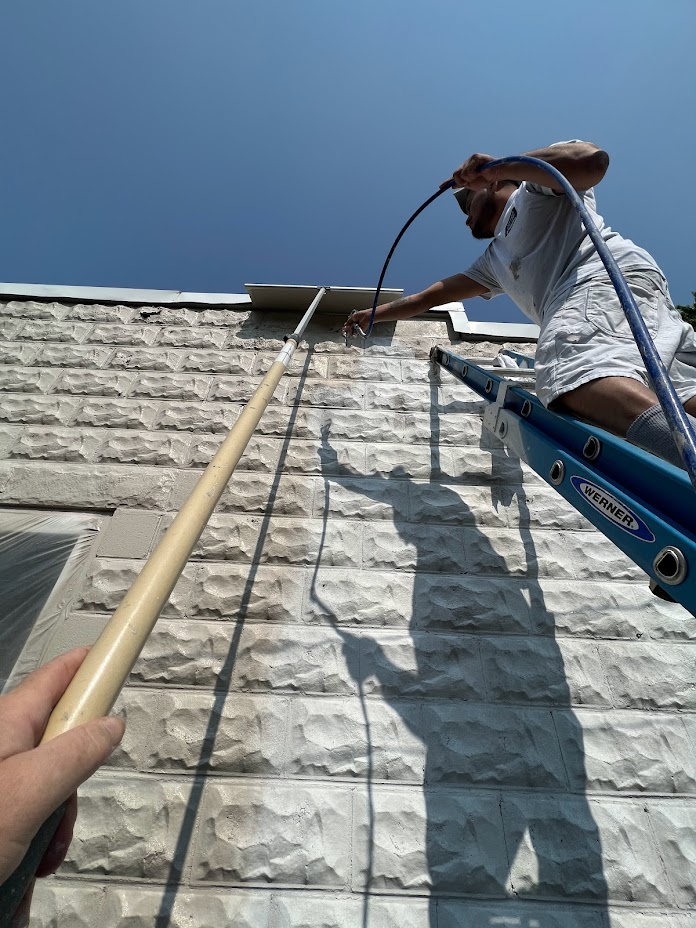
When it comes to exterior painting, choosing the right application method—spray, brush, or roller—can significantly impact the outcome of your project. Each method has its own advantages and disadvantages, and understanding their differences can help you make an informed decision. Let’s explore the pros and cons of each technique:
Spray Painting:
Pros:
- Speed: Spray painting is the fastest application method, covering large areas quickly and efficiently. It’s ideal for large exterior surfaces such as siding, fences, and decks.
- Uniform Finish: Sprayers produce a smooth, uniform finish without brush marks or roller texture. This can result in a more professional-looking paint job, especially on smooth surfaces.
- Accessibility: Sprayers can reach areas that are difficult to access with brushes or rollers, such as tight corners, eaves, and intricate architectural details.
- Even Coverage: Sprayers apply paint evenly and penetrate into cracks and crevices, ensuring thorough coverage and better protection against the elements.
Cons:
- Overspray: Spraying can create a fine mist of paint particles that may drift and settle on nearby surfaces, leading to overspray and potential damage if not properly controlled.
- Waste: Spraying can waste more paint than other methods, as some paint may be lost to overspray or evaporate before reaching the surface.
- Weather Dependency: Spraying is highly dependent on weather conditions, such as wind and humidity. Wind can cause overspray and make it difficult to control the direction of the spray, while high humidity can affect paint drying times.
Brush Painting:
Pros:
- Control: Brush painting offers maximum control over paint application, allowing for precise edging, cutting in, and detailing. It’s ideal for trim, windows, doors, and other intricate areas.
- Versatility: Brushes can be used on a variety of surfaces, including wood, metal, and masonry. They’re suitable for both smooth and textured surfaces, providing flexibility in application.
- No Overspray: Brush painting eliminates the risk of overspray, making it a safer option for nearby surfaces and landscaping.
- Easy Cleanup: Brushes are easy to clean with soap and water, making them convenient for DIYers and professionals alike.
Cons:
- Time-Consuming: Brush painting is the slowest application method, requiring more time and effort to cover large areas. It may not be practical for extensive exterior painting projects.
- Potential Brush Marks: Brush strokes can leave behind visible marks and texture on the painted surface, especially if not applied evenly or smoothly.
- Fatigue: Brush painting can be physically demanding, especially for long periods or on challenging surfaces. It may require frequent breaks to prevent fatigue and ensure quality results.
Roller Painting:
Pros:
- Efficiency: Roller painting is faster than brush painting and offers better coverage on large, flat surfaces such as walls, ceilings, and siding.
- Smooth Finish: High-quality rollers produce a smooth, uniform finish with minimal texture or roller marks. They’re ideal for smooth or semi-smooth surfaces.
- Less Waste: Rollers can be more efficient than brushes, requiring less paint and producing minimal waste. They’re suitable for projects with large surface areas.
Cons:
- Limited Control: Rollers offer less control than brushes, making them less suitable for detailing, cutting in, or painting around obstacles.
- Texture: Rollers can create a slight texture or stippling effect on the painted surface, especially on rough or textured surfaces. This may not be desirable for all applications.
- Cleanup: Roller cleanup can be more time-consuming than brush cleanup, as rollers require thorough rinsing and drying to remove all traces of paint.
In summary, each exterior painting method—spray, brush, and roller—has its own advantages and limitations. The best choice depends on factors such as the size and complexity of the project, the type of surface being painted, and your skill level and preferences. For optimal results, consider combining different techniques as needed to achieve the desired finish and quality.
